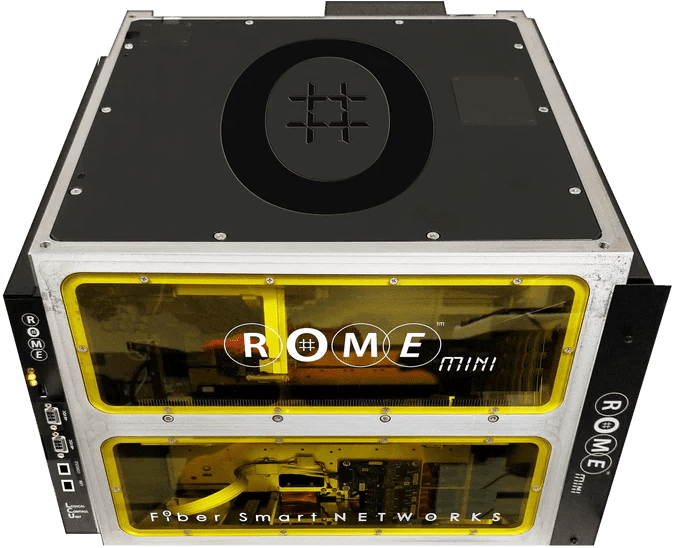The rapid evolution of digital infrastructure—driven by 5G, AI, edge computing, and hyperscale data centers—demands a new approach to fiber optic connectivity. FiberSmart’s Robotic Optical Management Engine (ROME) introduces a groundbreaking “cross bar technology,” blending robotic precision with software-defined networking to automate and optimize physical fiber connections. This white paper explores the mechanics of ROME’s cross bar system, its unique advantages, and its transformative potential for fiber applications in telecom, enterprise, and mission-critical environments.
Introduction
Fiber optics form the backbone of modern communication networks, delivering unparalleled bandwidth and reliability. However, managing these networks at the physical layer (Layer 0) has remained a manual, labor-intensive process—until now. FiberSmart’s ROME system redefines this paradigm with its robotic cross bar technology, enabling dynamic, scalable, and remote management of optical fiber connections. This paper delves into the technology’s core components and why it stands out as a game-changer for fiber applications.
Understanding Cross Bar Technology in ROME
Definition and Mechanics
In traditional telecommunications, a crossbar switch is a grid-like mechanism that connects any input to any output, ensuring non-blocking communication. FiberSmart adapts this concept into ROME, replacing electronic switching with a robotic system that physically manipulates fiber optic cables. Key elements include:
- Robotic Cross-Connect: Two robotic arms within each ROME unit navigate a dense fiber matrix, connecting and disconnecting cables with sub-millimeter precision.
- Smart CLOS Architecture: A multi-stage, non-blocking topology, managed by ROME OS software, optimizes interconnections across thousands of fibers.
- Physical Matrix: Models like ROME MAX support up to 2000 fibers in a single rack, organized into an addressable grid for seamless any-to-any connectivity.
- Optical Purity: Connections remain fiber-to-fiber, preserving signal integrity with minimal insertion loss and protocol transparency.
This hybrid of robotics and software creates a “cross bar” system that automates Layer 0, traditionally the most static layer of network infrastructure.
How It Works
- Input Command: Network operators issue commands via ROME OS to reconfigure fiber connections.
- Robotic Action: The system’s robots locate and adjust specific fibers within the matrix, completing tasks in seconds.
- Verification: Built-in monitoring ensures connection accuracy and optical performance.
- Adaptation: The system can reroute traffic or scale capacity dynamically, without human intervention.
Why ROME’s Cross Bar Technology is Unique
1. Automation at the Physical Layer
Manual fiber patching is slow, error-prone, and costly. ROME eliminates this bottleneck by automating physical connections, reducing provisioning times from hours to seconds and minimizing human error.
2. Unmatched Scalability
With support for thousands of fibers in a compact footprint (e.g., 2000 fibers in ROME MAX), the system scales effortlessly to meet the needs of hyperscale data centers, telecom hubs, and edge deployments.
3. Remote and Instant Management
Operators can reconfigure networks remotely, whether from a control room or a mobile device. This capability enhances flexibility, security, and response times—critical during outages or in remote locations.
4. Resilience and Longevity
ROME’s mechanical latching ensures connections persist during power failures, while its 3-million-cycle lifespan guarantees decades of reliable operation. Autonomous rerouting around damaged fibers further boosts uptime.
5. Cost Efficiency
By slashing labor costs and accelerating deployment, ROME delivers significant savings. Juniper Networks, for instance, reports $500,000 in annual savings per unit, highlighting its economic impact.
6. Future-Proof Design
As bandwidth demands soar—driven by 4K/8K streaming, VR, and military applications—ROME’s adaptability ensures networks remain agile and cost-effective over time.
Applications and Impact
Telecom and Data Centers
ROME enables rapid provisioning of customer circuits, dynamic load balancing, and efficient peering, making it ideal for 5G rollouts and cloud infrastructure.
Edge Computing
In remote edge sites, ROME’s automation and resilience ensure reliable connectivity with minimal on-site maintenance, supporting IoT and real-time analytics.
Mission-Critical Operations
For military or emergency services, ROME’s instant reconfiguration and outage-proof design deliver secure, uninterrupted communication in high-stakes scenarios.
Conclusion
FiberSmart’s ROME system, with its innovative cross bar technology, marks a paradigm shift in fiber optic management. By combining robotic precision, high-density scalability, and software intelligence, it transforms Layer 0 into a dynamic, efficient, and future-ready layer. As fiber networks become the “nervous system” of our digital world, ROME stands poised to drive connectivity into the next era—delivering speed, savings, and reliability like never before.
Call to Action
Organizations seeking to modernize their fiber infrastructure should explore ROME’s capabilities. Contact FiberSmart for a demonstration or pilot deployment to experience the future of optical networking firsthand.











